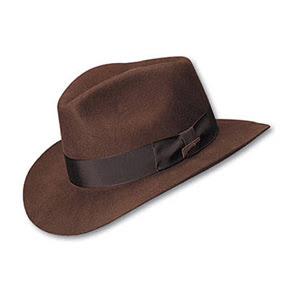And yet it has fallen out of fashion to wear a hat, other than a baseball cap or a knit hat if it’s really cold. Hats are actually practical and useful, as they keep the rain off your head, shield your eyes from the bright sun, and help keep your head warm.
I have several very nice neckties, though I bought them all at least six or eight years ago so presumably they’re long since out of fashion. I also have a wool fedora, Indiana Jones-style. Of the two garments, I’d much rather be wearing the hat, though I’m glad it’s not a requirement. Thankfully, the necktie is far less often mandatory than it once was, but there’s still a wide range of situations where it’s expected – weddings, funerals, trials, and job interviews all expect a man to wear a tie. But why?
Historically, the precursors to the necktie were the ruff and the cravat, dating back to the 1500 and 1600s, respectively. And the basic concept of wrapping a hunk of cloth around the neck has endured for some four hundred years in various forms. The modern necktie was born around the end of World War I and has been a fixture at formal events and board rooms ever since. Which is really where I have difficulty with it. As a decorative accessory – a garment that somebody elects to wear because they like the way it looks (or the way it makes them look) – it’s reasonably harmless. People wear lots of kooky stuff and I generally don’t get too worked up about it.
But at some point, the necktie became mandatory. You weren’t sufficiently “dressed up” if you weren’t wearing one. I get the idea that society requires certain standards of dress to signify that a given social situation is grave or important or due a level of respect and solemnity. I just don’t really grasp how the necktie got involved in that, to the point that you weren’t fully dressed if you weren’t wearing one. How many people have been sent home from work to put on a tie? How many prospective employees have failed to be hired because they (for whatever reason) elected not to wear a tie to their interview? I get that it’s not the tie itself that was important as much as the symbolism associated with it, and surely the folks who chose to disregard that symbolism did so at their own social peril. But I’m just as glad that they’re slowly fading into obscurity.
I’ll admit, I feel “dressed up” when I put on a tie, much as I loathe wearing one. And as a crotchety no-longer-young man who is well on his way to being a crotchety old man, I’m aware that I’m going to continue to want a way to identify the “well-dressed” from the “slobs,” the “serious-minded professionals” from the “unkempt slobs.” The necktie was a convenient way of sorting people into convenient categories, and if it manages to pass completely there may not be anything to replace it. Because, as of yet, there has been nothing to replace it. The trend has been increasingly toward “casual,” with no single article actually replacing the tie’s symbolic significance. The question is, how long will the necktie, which is at best a 20th-century anachronism, continue to be the single article that defines “dressed up” and, if at some point it no longer is, what will serve that function in its place? I’m going to need to know, because at some point my kids will most likely get married and I will certainly someday need to be properly laid out in my casket. Until then, I have no particular plans to wear a tie.
My hat, on the other hand…




http://asuitablewardrobe.dynend.com/
ReplyDeleteSee, the "A Suitable Wardrobe" guy clearly spends all sorts of time thinking about men's fashions. I only wonder about them when they annoy me.
ReplyDelete:-)
ReplyDelete